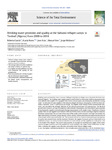Mostrar o rexistro simple do ítem
Drinking Water Provision and Quality at the Sahrawi Refugee Camps in Tindouf (Algeria) From 2006 to 2016
| dc.contributor.author | García, Roberto | |
| dc.contributor.author | Naves, Acacia | |
| dc.contributor.author | Anta, Jose | |
| dc.contributor.author | Ron, Manuel | |
| dc.contributor.author | Molinero-Huguet, Jorge | |
| dc.date.accessioned | 2022-03-09T16:00:42Z | |
| dc.date.available | 2022-03-09T16:00:42Z | |
| dc.date.issued | 2021 | |
| dc.identifier.citation | García, R., Naves, A., Anta, J., Ron, M., Molinero, J. (2021). Drinking water provision and quality at the Sahrawi refugee camps in Tindouf (Algeria) from 2006 to 2016. Science of The Total Environment, 780, 146504. ISSN 0048-9697. https://doi.org/10.1016/j.scitotenv.2021.146504. (https://www.sciencedirect.com/science/article/pii/S0048969721015722) | es_ES |
| dc.identifier.uri | http://hdl.handle.net/2183/29936 | |
| dc.description | Financiado para publicación en acceso aberto: Universidade da Coruña/CISUG | es_ES |
| dc.description.abstract | [Abstract] Drinking water provision has been a constant challenge in the Sahrawi refugee camps, located in the desert near Tindouf (Algeria). The drinking water supply system is itself divided in three zones which pump groundwater from different deep aquifers. It is equipped with reverse osmosis plants and chlorination systems for treating water. The allocation of water supplied to the Saharawi refugees for human consumption in 2016 has been estimated at between 14 and 17 L/person/day on average. This supplied water volume is below recommended standards, and also below the strategic objective of the Sahrawi government (20 L/person/day). Yet the local groundwater resources are huge in comparison with estimated consumption, and hence there is great potential for increasing the supplied volume through effecting improvements in the supply system. The physico-chemical quality of the raw and supplied water between 2006 and 2016 has been assessed according to Algerian standards for human consumption. The raw water of two zones of the supply system presents a very high conductivity and high concentrations of chloride, nitrate, fluoride, sulfate, sodium, calcium, potassium and iodide concentrations of natural origin, which may entail health risks. The treatment of water in a reverse osmosis plant greatly improves its quality and osmosed water met the standards. However, the supply of osmosed and raw water needs to be combined in Zone 1, to avoid an excessive reduction in water volume, and the supplied raw water poses a risk to the health of the refugees. The present study provides an example of a drinking water supply system under extreme drought conditions and in the political and social conditions of a refugee camp. Furthermore, it establishes a reference for supplied water allocation and quality in the Sahrawi refugee camps. | es_ES |
| dc.language.iso | eng | es_ES |
| dc.publisher | Elsevier | es_ES |
| dc.relation.uri | https://doi.org/10.1016/j.scitotenv.2021.146504 | es_ES |
| dc.rights | Atribución-NoComercial-SinDerivadas 4.0 Internacional | es_ES |
| dc.rights.uri | http://creativecommons.org/licenses/by-nc-nd/4.0/ | * |
| dc.subject | Sahara | es_ES |
| dc.subject | Refugee camp | es_ES |
| dc.subject | Water supply system | es_ES |
| dc.subject | Drinking water quality | es_ES |
| dc.title | Drinking Water Provision and Quality at the Sahrawi Refugee Camps in Tindouf (Algeria) From 2006 to 2016 | es_ES |
| dc.type | info:eu-repo/semantics/article | es_ES |
| dc.rights.access | info:eu-repo/semantics/openAccess | es_ES |
| UDC.journalTitle | Science of The Total Environment | es_ES |
| UDC.volume | 780 | es_ES |
| UDC.startPage | 146504 | es_ES |
| dc.identifier.doi | 10.1016/j.scitotenv.2021.146504 |






